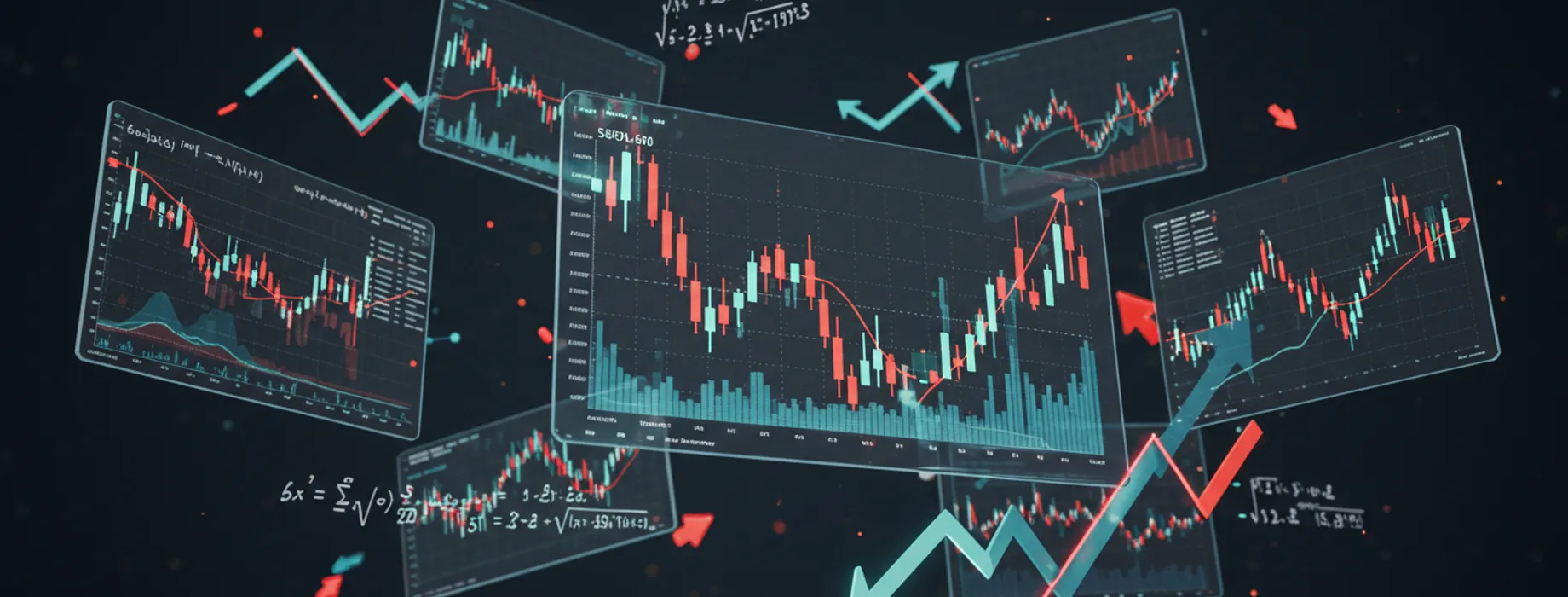- Does this approach survive bad markets?
- Is it consistent, or just lucky over a short window?
- What kind of drawdowns, wins, and volatility should I expect?
Backtesting Trading Strategies:Complete Testing Framework Guide

A strategy may look great on paper — but until you’ve seen how it performs in real conditions, it’s just a theory.That’s where backtesting trading strategies come in — the process of applying your trading method to real historical data to see how it truly performs. It’s the process of taking your trading setup and running it through real historical data to see how it would’ve behaved — not hypothetically, but based on actual market movement.
Done right, backtesting helps you answer the questions that matter:
In this guide, we’ll show you exactly how to:
- Choose the right data sources
- Set up a clear testing structure
- Track results with useful metrics
- Avoid the false confidence of “perfect” past results
No matter your strategy — breakout, trend-following, binary setups, or algo systems — this framework will help you test smarter and trade with confidence. This process is a core part of trading strategy testing, helping traders validate setups through historical data analysis. Without this step, any strategy lacks proper strategy validation before going live.
📚 Backtesting Trading Strategies: What It Is and Why It Matters
Backtesting is the process of checking how a trading strategy would have worked in the past, using real market data — without risking actual capital.
It’s not about predicting the future. It’s about understanding how your rules behave under different market conditions. If your strategy only works during bull runs or gets wiped out during high volatility, backtesting will reveal that before you put real money on the line.
🛠 Why Backtesting Isn’t Optional
Many traders skip testing and go straight to live trades, relying on gut feeling or “what worked last week.” That usually ends badly.
Here’s why proper backtesting is essential:
- It filters out bad ideas quickly
- It builds statistical confidence in your edge
- It saves time and money by avoiding avoidable losses
- It turns subjective setups into measurable systems
Skipping backtesting trading strategies often leads to relying on luck rather than logic — and that’s a recipe for disaster.
🔄 Backtest vs. Forward Test
- Backtest = run the strategy on past data, fast, with no emotional bias
- Forward test = apply the strategy in real time with small capital or demo account to see how it performs under real-world conditions
Backtesting shows potential. Forward testing shows survivability.
Both are critical before scaling up.
📁 Choosing the Right Historical Data
The quality of your backtest depends on one thing above all: the data you feed into it. If your source is incomplete, inaccurate, or outdated — your results will lie to you.
Backtesting is only as reliable as the price history it runs on. Strong historical data analysis ensures that the patterns, noise, and structure of market behavior are accurately reflected in your backtest results.
🔎 What Makes Data “Good”?
- Clean — no missing candles, spikes, or duplicate entries
- Detailed — the right resolution for your strategy (e.g., minute, hourly, daily)
- Relevant — covers the exact asset and time period your system needs
- Aligned — includes session times, timezone corrections, and trading hours
For example, scalping on 1-minute charts? You’ll need tick or minute-level data.
Testing swing trades on 4H candles? Daily or hourly is likely enough.
📦 Where to Get Historical Data
- Free Sources:
- TradingView (limited depth)
- Yahoo Finance (EOD data)
- Investing.com (some intraday)
- Premium/Professional:
- MetaTrader 5 historical center
- TickData, Quandl, Dukascopy
- Polygon.io, Intrinio
If you backtest short-term trading strategies — especially those with fixed timeframes — make sure your historical data matches the actual expiry windows and market conditions. For platforms offering short-term trading contracts, accuracy of timestamps is critical.
Bad data = bad results. If your strategy looks great on broken history, it will collapse live.
🧪 How to Build a Testing Framework
Backtesting isn’t just about running a strategy through data — it’s about doing it with structure, logic, and repeatability. That’s what turns raw ideas into validated systems.
Here’s how to build a testing process that gives you answers you can trust.
🔧 1. Define Clear Rules
No vague terms like “enter when it feels right.”
Every backtest must follow strict conditions for:
- Entry — exact setup (e.g. RSI < 30 + bullish candle close)
- Exit — fixed target, trailing stop, or reversal signal
- Risk management — position size, stop loss, and max drawdown
Without consistent rule definition, any strategy validation attempt becomes flawed and unreliable.
⏱ 2. Set Timeframe and Asset
- Choose the chart interval that fits your method (e.g. 5m, 1h, daily)
- Test only on markets where you intend to trade — not just where it looks good
Don’t test a gold strategy on EUR/USD just because the data is easier to find.
💸 3. Include Costs and Slippage
- Apply real spreads, not ideal entries
- Include commissions or fees
- Simulate delayed execution if applicable (especially for fast-moving markets)
🛠 4. Choose a Testing Tool
| Tool | Ideal For |
|---|---|
| TradingView | Manual visual testing, Pine Script backtest |
| Excel/Google Sheets | Custom rule-based strategies, simple models |
| MetaTrader 5 | Built-in strategy tester (automated) |
| Python (Pandas/Backtrader) | Full automation, deep analytics |
No-code trader? No problem. You can start by logging trades manually from charts to get a feel for system behavior before automating anything.
📈 Key Metrics to Track
Backtesting isn’t just about wins and losses — it’s about the quality of those results.
You need the right metrics to measure performance, risk, and reliability.
Here are the most important numbers that separate lucky outcomes from real edges:
📊 Performance Metrics Table
| Metric | What It Tells You |
|---|---|
| Win Rate | % of trades that ended in profit |
| Risk/Reward Ratio | Average profit per trade vs. average loss |
| Max Drawdown | Largest % decline from peak equity |
| Sharpe Ratio | Return relative to volatility (risk-adjusted return) |
| Profit Factor | Gross profits ÷ gross losses — shows efficiency |
| Expectancy | Average return per trade over time |
🧠 How to Use These Numbers
- High win rate + bad risk/reward = fragile system
- Lower win rate + strong profit factor = sustainable edge
- High drawdown = you may quit before the system works
Don’t chase perfect stats. Look for stable, consistent behavior across different timeframes or market conditions. That’s what tells you a strategy is reliable — not just lucky in one test.
🧠 From Backtest to Real Trade: Mistakes to Avoid & How to Apply Results
Backtesting can be powerful — but only if it’s done right. Many strategies look amazing in testing but fail miserably live. Why? Because traders often test the wrong way — or misinterpret what the data is telling them.
Let’s break down the most common mistakes and how to avoid them when turning your test results into real trades.
❌ Common Backtesting Mistakes
- Overfitting
You tweak the strategy to perform perfectly on past data — but it only fits that dataset. In real conditions, it collapses. - Ignoring execution reality
No slippage, zero spread, instant fills — not realistic. Always simulate real-world costs. - Testing on cherry-picked time periods
“Look how it worked in 2020!” — that’s not a test, it’s a highlight reel. Use mixed markets: trending, ranging, volatile, calm. - Changing rules mid-test
If you adapt rules after each bad trade, you’re not testing — you’re curve-fitting.
✅ Turning Test Results into Actionable Trading
So your strategy shows promise — what now?
- Forward test it on live charts using a demo or small capital. Watch how it behaves when money (and emotion) is involved.
- Document everything — wins, losses, emotional reactions. See if the system holds up mentally, not just mathematically.
- Refine gradually, not reactively. One bad week doesn’t mean failure. Adjust based on consistent patterns, not isolated outcomes.
- Scale slowly — if it works on $100, try $500, then $1000. Grow with confidence, not urgency.
Pro tip: Just because a system “works” on paper doesn’t mean you can execute it well. The true test is when your discipline meets the market.
🧾 Conclusion
Backtesting isn’t about finding perfect results — it’s about building evidence and structure behind your strategy. It helps you cut through hype, clarify expectations, and prepare for real-world execution.
Whether you trade full-time or just on weekends, a tested strategy gives you more than numbers — it gives you confidence.
Because in trading, the edge doesn’t come from guessing right. It comes from knowing what your system is likely to do — and what you’ll do with it. In the long run, mastering backtesting trading strategies sets apart consistent traders from hopeful speculators.
📚 Sources & References
- TradingView – Backtesting Tools & Pine Script
www.tradingview.com - Babypips – Strategy Development 101
www.babypips.com - CMT Association – Quantitative Testing Frameworks
www.cmtassociation.org - Pocket Option – Strategy Testing in Binary Setups
www.pocketoption.com
FAQ
Is backtesting only for coders and algos?
Not at all. Many traders backtest manually using charts, spreadsheets, or tools like TradingView. Coding just makes it faster — not better by default.
How many trades should I test?
Aim for at least 100+ trades across different market phases. The more, the better — but only if the rules stay consistent.
Can I backtest binary options strategies?
Yes — especially if you're using fixed expirations and conditions. Just make sure to simulate realistic payout ratios and entry timing.
Do I need paid data?
Not necessarily. Free data is enough for most strategies, but if you need tick-level accuracy or institutional-grade testing, paid sources are worth it.
Is backtesting effective for objective strategy validation?
Yes. When combined with solid historical data analysis, trading strategy testing through backtesting gives factual, repeatable insight into the viability of your method under real conditions. It’s the first step in serious strategy validatio
